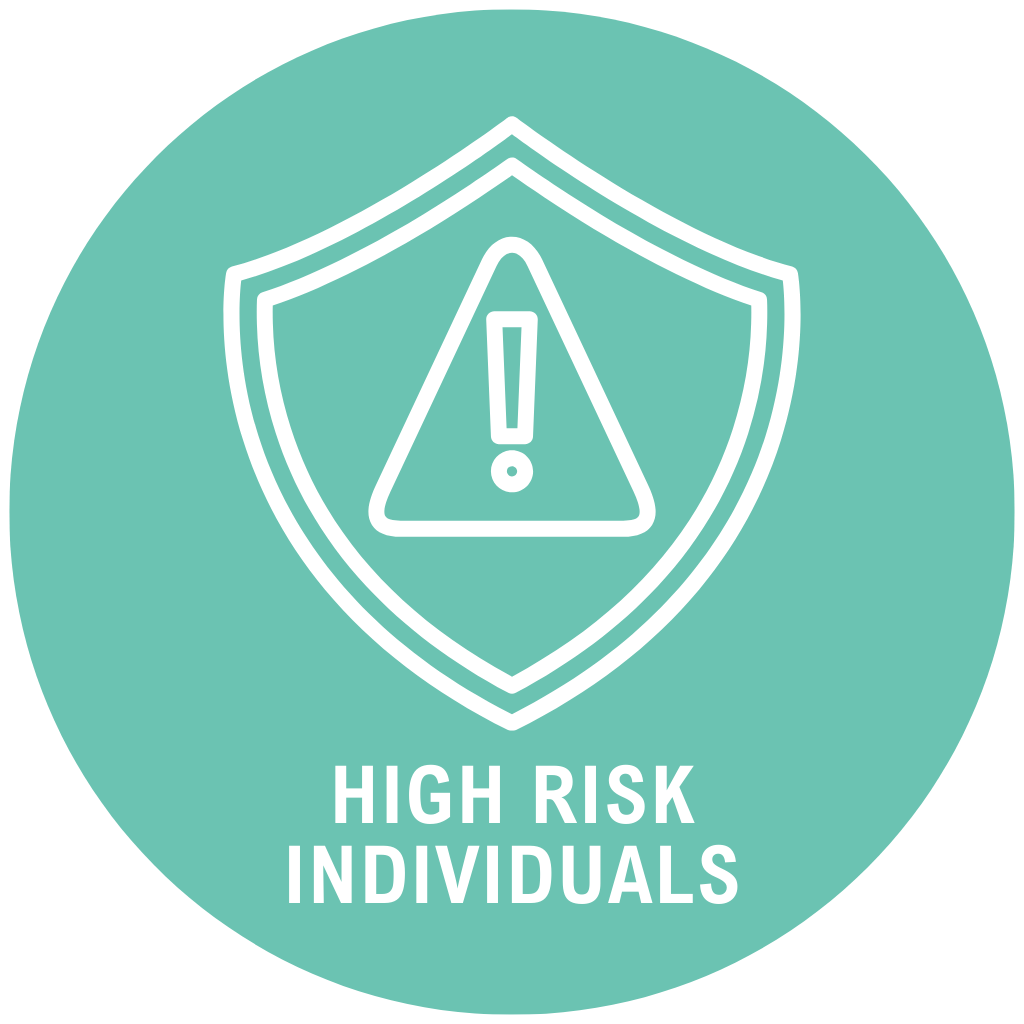Flu is a contagious respiratory illness caused by influenza viruses that infect the nose, throat, and sometimes the lungs. Flu can cause mild to severe illness that is easily spread from person to person. The best way to protect yourself and your family against flu is by getting vaccinated. Vaccination against the flu prevents millions of illnesses, reduces the need for doctor visits and hospitalizations, and saves lives every year.
- SymptomsSymptoms
- About FluAbout Flu
- People at High RiskPeople at High Risk
- PreventionPrevention
- TreatmentTreatment
- Signs of ComplicationsSigns of Complications
- FAQsFAQs

Influenza (flu) Virus Symptoms
The Influenza (flu) virus can cause mild to severe illness and sometimes lead to death. Flu symptoms usually come on suddenly. People who have flu often feel some or all of these symptoms:
- fever or feeling feverish/chills
- cough
- sore throat
- runny or stuffy nose
- muscle or body aches
- headaches
- fatigue (tiredness)
- some people may have vomiting and diarrhea, though this is more common in children than adults.

About Flu
Influenza, commonly known as the flu, is a contagious respiratory illness caused by influenza viruses that infect the nose, throat, and sometimes the lungs. Influenza is a contagious viral infection. Viral infections are any illness from a virus (a tiny germ that uses your cells to reproduce). Flu can cause mild to severe illness. Serious outcomes of flu infection can result in hospitalization or death. Some people, such as older people, young children, and people with certain health conditions, are at high risk of serious flu complications.
The best way to prevent the flu is by getting the flu shot each year.
The best way to prevent the flu is to get the flu vaccine yearly. Vaccines train your immune system to recognize infections and fight them off before you get sick. The influenza virus can change (mutate) a little bit every year, which is why the Centers for Disease Control and Prevention (CDC) recommends a yearly flu shot (vaccine) for everyone 6 months of age and older.

People at High Risk
Anyone can get sick with the flu, even healthy people, and serious problems related to the flu can happen to anyone at any age. Still, some people are at higher risk of developing serious flu-related complications if they get sick. This includes people 65 years and older, people of any age with certain chronic medical conditions (such as asthma, diabetes, or heart disease), pregnant people, and children younger than 5 years old, but especially those younger than 2 years old.
Flu shots are especially important for people aged 65 and older because they have a higher risk of getting very sick from the flu. For older adults, doctors recommend special flu vaccines that have a higher dose or added ingredients to help the vaccine work better, instead of the regular flu shots. For more information, see Flu and People 65 Years and Older.

Flu Prevention
- Getting the flu vaccine every year is the best way to prevent seasonal flu and the best protection against severe illness and death. Visit MyTurn to schedule your vaccines or contact your healthcare provider.
- Avoid close contact, especially with people who are sick: When you are sick, keep your distance from others to prevent them from getting sick too.
- Stay home when you are sick: Stay home and away from others if you have any symptoms. Stay home from work, school, and errands when you’re sick. You can go back to your normal activities when, for at least 24 hours, both are true:
- Your symptoms are getting better overall, and
- You have not had a fever (and are not using fever-reducing medication).
- Wash your hands: Wash your hands often with soap and warm water for at least 20 seconds. If soap and water are unavailable, use a hand sanitizer with at least 60% alcohol.
- Cover your mouth and nose: Cough or sneeze into your elbow, arm, or disposable tissue. Wearing a mask is an additional prevention strategy that you can choose to do to further protect yourself and others.
- Avoid touching your eyes, nose, or mouth: Germs are often spread when a person touches something that is contaminated with germs and then touches his or her eyes, nose, or mouth.
- Consider Wearing a Mask: Wearing a mask can slow the spread of respiratory viruses. If you or your family member are at high risk for severe illness, consider wearing a mask, especially in public indoor or crowded spaces. For more information, visit When and Why to Wear a Mask.
- Avoid sharing utensils: Don’t share food or eating utensils (forks, spoons, cups) with others.
- Practice other good health habits: Clean and disinfect frequently touched surfaces at home, work or school, especially when someone is ill. Get plenty of sleep, be physically active, manage your stress, drink plenty of fluids, and eat nutritious food.
Learn more about Health Habits to Help Prevent the Flu.
Learn more about respiratory virus prevention.

Treatment
- Can flu be treated?
Yes. There are prescription medications called “influenza antiviral drugs” that can be used to treat flu illness. These drugs work best when started early, such as one to two days after flu symptoms begin. - What are flu antiviral drugs?
Flu antiviral drugs are prescription medicines (pills, liquid, an inhaled powder, or an intravenous solution) that fight against flu in your respiratory tract. Antiviral drugs are not sold over the counter. You can only get them if you have a prescription from a doctor or health care provider. Antiviral drugs are different from antibiotics, which fight against bacterial infections. - When should I get treated? Most people get better from the flu without needing antiviral treatment. The CDC recommends immediate treatment for people who have or might have the flu and are at higher risk for serious problems. This includes people who are pregnant, have asthma or other lung problems, diabetes (including during pregnancy), or heart disease. Be sure to see your doctor for help. For more information, see antivirals.
- Can you use antibiotics?
- No. When you have flu, antibiotics will not help you feel better. Antibiotics don’t treat the flu virus, and their side effects could cause harm.
- Side effects of antibiotics can range from minor issues, like a rash, to very serious health problems, such as
- Antimicrobial-resistant infections, which are difficult to treat and cure
- C. diff infection, which causes severe diarrhea that can lead to severe colon damage and death.

Signs of Complications
Most people who get flu recover in a few days to less than two weeks, but some develop complications (such as pneumonia), some of which can be life-threatening and result in death.
People experiencing these warning signs should obtain medical care right away.
| Children | Adults |
| Fast breathing or trouble breathing | Difficulty breathing or shortness of breath |
| Blush lips or face | Persistent pain or pressure in the chest or abdomen |
| Ribs pulling in with each breath | Persistent dizziness, confusion, inability to arouse |
| Chest pain | Seizures |
| Severe muscle pain (child refuses to walk) | Not urinating |
| Dehydration (no urine for 8 hours, dry mouth, no tears when crying) | Severe muscle pain |
| Not alert or interacting when awake | Severe weakness or unsteadiness |
| Seizures | Fever or cough that improves but then returns or worsens |
| Fever above 104 degrees Fahrenheit that is not controlled by fever-reducing medicine | Worsening of chronic medical conditions |
| In children younger than 12 weeks, any fever | |
| Fever or cough that improves but then returns or worsens |
These lists are not all-inclusive. Please consult your medical provider for any other symptom that is severe or concerning.
Learn more about Flu Symptoms & Complications.

Frequently Asked Questions
- All flu vaccines in the United States for the 2024-2025 season will protect against three main types of flu viruses. Most flu shots this season will be made without or with less of a preservative called thimerosal.
- The Advisory Committee on Immunization Practices (ACIP) recommends that everyone 6 months and older get a flu vaccine each year, unless they have a reason not to.
- The CDC does not recommend one specific flu vaccine for people under 65 years—any approved flu vaccine is fine, as long as it is appropriate for their age and health. For people 65 and older, three specific vaccines are recommended because they tend to work better for this age group.
- There are many vaccine options, but the most important thing is that everyone (6 months and older) gets vaccinated each year. If you have questions about which vaccine is best for you, talk to your doctor or healthcare provider.
- People with serious allergic reactions to ingredients or babies younger than 6 months should not be vaccinated. Be sure to discuss with your doctor if you should not receive a flu vaccine.
- Most people should get their flu shot in September or October, and everyone should be vaccinated by the end of October. Here are some important points about when to get vaccinated:
- Children: Some children need two doses of the flu vaccine. It is best for them to receive their first dose as soon as the vaccine is available, so the second dose can be given at least four weeks later. Children, who need only one dose, may be vaccinated in July or August.
- Pregnant individuals: Pregnant individuals in their third trimester can be vaccinated in July or August. This helps protect their babies for the first few months after they are born (when they are too young to be vaccinated).
- Adults: Most adults, especially those 65 and older and pregnant people in early pregnancy, should not get vaccinated too early (like in July or August) because the vaccine may not work as well later. However, if someone cannot return for a shot later, they can get be vaccinated earlier.
- Yes. Coadministration is a common practice that involves getting more than one vaccine during the same visit. Most vaccines, including the flu, COVID-19, and RSV vaccines, can be given together. If you are eligible, you can get all your fall and winter vaccines during the same visit.
- If you prefer to get each vaccine at a different time, you can do that too, and there’s no waiting period between them. It’s important to stay up-to-date on your vaccines to stay protected this season. If you have questions about these vaccines, talk to your healthcare provider or pharmacist.

GET YOUR FREE FLU SHOT TODAY!
For a limited time, free updated Flu and COVID-19 vaccines are available to those who live, work, and go to school in San Bernardino County! Vaccination against the flu and COVID-19 is a safe and powerful tool to help prevent severe illness, doctor visits, hospitalizations, and even death.
Make an appointment for your vaccines at MyTurn.ca.gov.
The San Bernardino County Department of Public Health urges residents to take proactive measures to protect themselves against respiratory viruses, including COVID-19, seasonal influenza (flu), and respiratory syncytial virus (RSV). View the health advisory.
Flu, Cold, RSV or COVID-19
The flu, common cold, COVID-19, and Respiratory Syncytial Virus (RSV) are all contagious respiratory illnesses caused by different viruses. Because some of the symptoms of these respiratory viruses are similar, it may be hard to tell the difference between them based on symptoms alone, and testing may be needed to help confirm a diagnosis.
To learn the difference between the three illnesses, visit the links below:
Similarities and Differences between Flu and the Common Cold
Similarities and Differences between Flu and COVID-19
Respiratory syncytial virus (RSV)
Learn about those who are at higher risk for flu complications.
Immunization Registry Notice to Patients and Parents (Aviso del registro de inmunizaciones para pacientes y padres)
Notice of Privacy Practices (Notificación de Prácticas de Privacidad)
Vaccine Information Statement (VIS) (Declaración de Información Sobre la Vacuna)
VAERS: Report Vaccine Adverse Events & Administration Errors
San Bernardino County Influenza & ER Visit Tracker
View the total of daily count of emergency department visits due to influenza and daily counts of hospitalizations on our Influenza-Like Surveillance Dashboard.
Local Partners
San Bernardino County is a proud partner of the FightFluTogether Coalition
The FightFluTogether Coalition comprises hospitals, health care systems, providers, public health professionals, health departments, and community organizations, including the Centers for Disease Control and Prevention, the California Department of Public Health, and the California Hospital Association. The coalition’s goal is to educate the community on the importance of the flu vaccine and encourage individuals to get the flu shot by providing resources on how and where to get the vaccine.

